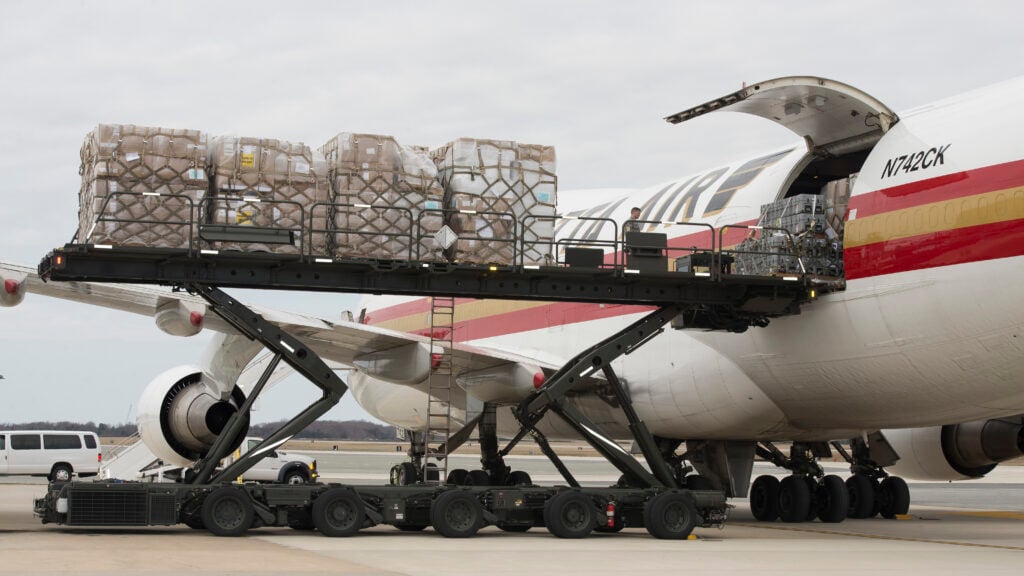
Cargo pallets are loaded onto a Kalitta Air Boeing 747 by 436th Aerial Port Squadron Airmen March 24, 2017, at Dover Air Force Base, Del. In addition to military airlifters, Dover AFB regularly sees civilian cargo planes that support Department of Defense missions. (US Air Force photo by Senior Airman Zachary Cacicia)
WASHINGTON — The Space Force today is meeting with officials from other government agencies, and on Friday with industry, to discuss how the Defense Department might build a Commercial Augmentation Space Reserve — a space parallel to the existing air and maritime civil reserve fleets that can be called up by the government in times of crisis or conflict to support military missions.
The discussions are being led by Space Systems Command’s “Front Door” team, which is the acquisition command’s one-stop-shop for facilitating connections between industry and potential Space Force customers. The Front Door portal is being managed with the assistance of SAVI LLC, Intervallo LLC, Tecolote Research Inc., and The Aerospace Corporation.
“[M]ost of the forum is ‘sausage making’ of a concept,” explained Jen Ross, a Front Door representative from Intervallo, in an email to Breaking Defense.
Chirag Parikh, the executive secretary of the National Space Council, said today that one of the key issues facing government and industry as commercial space companies increasingly are providing national security services is how to ensure that those firms are able “to operate in crisis and conflict.”
“Just as we saw the value of commercial space systems in the Ukraine crisis, we’ve also seen the potential vulnerability and [the possibility for] commercial capabilities to be attacked as well. And so we’ve got to consider commercial capabilities and how they operate not just now, but also in the time of crisis. And certainly, we must consider how they must operate in a time of conflict as well,” he told the 25 Annual FAA Commercial Space Transportation Conference.
RELATED: SpaceX didn’t intend that Starlink be ‘weaponized’ by Ukraine, president says
Parikh said he was “happy” that the Space Force is taking the thought process “to heart” and trying to figure out the “space version” of the Civil Reserve Air Fleet (CRAF).
The issue of creating a space parallel to the Air Force’s CRAF or the Maritime Administration’s National Defense Reserve Fleet has been kicking around for a couple of years. Those fleets work essentially by the US government giving participating firms preferential treatment in exchange for them keeping some of their airplanes and ships at the ready to be rapidly called into action. Further, the US government guarantees participants some level of compensation should they be attacked.
The National Reconnaissance Office first publicly proposed in mid-2021 creating such a reserve fleet of commercial remote sensing firms contracted by the spy satellite agency to provide imagery. The catch was that NRO wanted to reserve the right to permanently commandeer imagery taken during the time when those satellites were “called up” — a contractual form of what is known as “shutter control” and a subject of long-standing debate.
There are a number of questions that the Space Force will have to answer in regards to expanding the civil reserve idea to space. One foundational issue is determining what missions actually would need to be rapidly augmented by commercial capabilities during a crisis or a war — from satellite communications (where the military already is heavily reliant on commercial providers), to intelligence, surveillance and reconnaissance to launch.
Another question is what, if any, industry sectors actually can at this moment set aside satellites or launch vehicles for potential call up.
“[T]he devils will be in the details. CRAF works because the participating air carriers are getting preferential business from the USG in return for agreeing to support future call-ups. There is a degree of fungibility within the air carrier world given how many commercial transport aircraft are in storage. That does not necessarily convey to commercial space systems. By its very nature, there is very little excess capacity in commercial space,” one industry executive noted.
Finally, there is the question of compensation — and what DoD can afford to take on as monetary liability.
For years, commercial satellite communications firms have been providing bandwidth for use by the military services with no promises that the US government would pay them for any losses should they become targets in wartime. Would the Space Force now change that policy, and compensate companies if their satellites are attacked or they are jammed over large areas causing them to lose business? And if not, how will the service be able to justify compensating only some types of providers and not others?
“Any commercial entity that is supporting, or is perceived to be supporting, the US military’s efforts is a target. Think about all the commercial shipping traffic lost to German U-boats during WWII. I’m not really sure how indemnification works in those scenarios since it’s the price of doing business,” the industry exec said.
“One approach could be the USG pays the delta in increased insurance costs to the owner/operators associated with supporting US military/intelligence requirements,” the exec added.
But at the moment, most commercial satellite operators do not even have insurance for on-orbit operations, only to cover potential losses during launch and initial orbital insertion. So, how exactly insurance might be involved is yet another unanswered question.
In a Taiwan conflict, tough choices could come for Big Tech
Washington could do more to incentivize tech companies to distance themselves from China, but CEOs should examine how they’d react to a fight in the Pacific, CSET’s Sam Bresnick and Emelia Probasco argue.


























